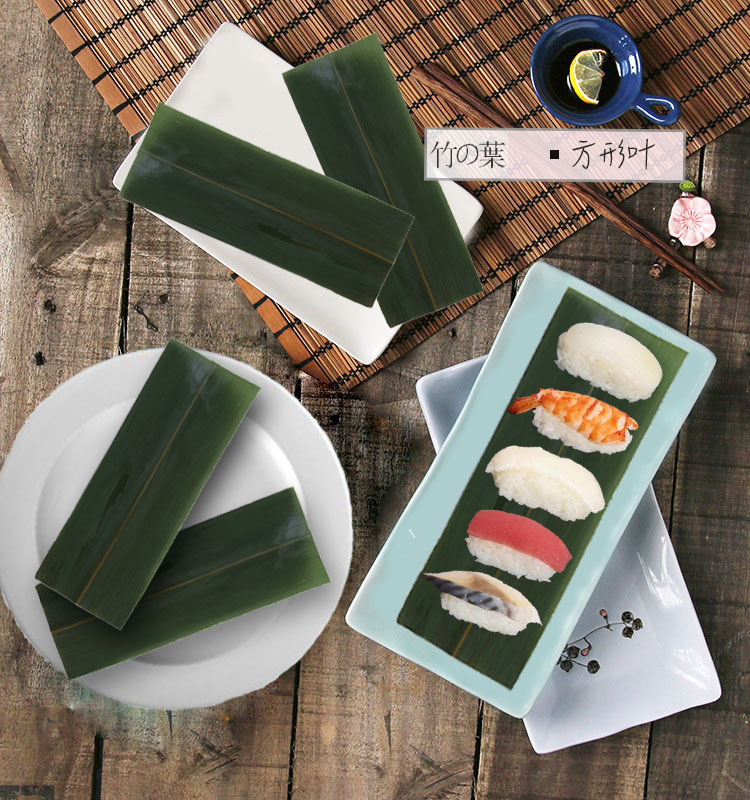Bamboo leaves are commonly used in various culinary practices, and one interesting application is their use in sashimi. Sashimi, a traditional Japanese dish, consists of thinly sliced raw fish or seafood that is often served with soy sauce and wasabi. While traditionally sashimi is presented on a bed of daikon radish, using bamboo leaves as an alternative provides a unique twist to this exquisite dish. In this article, we will explore the use of bamboo leaves for sashimi, its benefits, and how it enhances the overall experience for food enthusiasts.
Sashimi, a delicacy appreciated for its freshness and texture, is often served on traditional daikon radish slices. However, using bamboo leaves as an alternative offers a creative and visually appealing presentation. Bamboo leaves provide a distinctive aroma and taste that complements the raw fish or seafood, elevating the overall dining experience.
Bamboo leaves possess a unique flavor profile that adds depth and complexity to the sashimi dish. The leaves have a slightly earthy and grassy taste, which harmonizes with the delicate flavors of the raw fish. Furthermore, bamboo leaves offer an aesthetically pleasing backdrop, enhancing the visual appeal of the dish.
3. How to Prepare Bamboo Leaves for Sashimi
Before using bamboo leaves for sashimi, it is crucial to properly prepare them. Follow these steps for the best results:
Select fresh bamboo leaves from a trusted source.
Rinse the leaves thoroughly under running water to remove any impurities.
Boil the leaves in water for a few minutes to soften them and remove any bitterness.
Drain and pat dry the leaves with a clean kitchen towel.
Cut the leaves into appropriate sizes for the sashimi presentation.
4. The Role of Bamboo Leaves in Enhancing Flavor
The addition of bamboo leaves imparts a subtle yet distinct flavor to the sashimi. The leaves infuse a delicate essence into the raw fish, enriching its taste. This combination creates a harmonious blend of flavors that delights the palate and adds a unique touch to the dining experience.
5. Presenting Sashimi on Bamboo Leaves
To present sashimi on Fresh bamboo leaves, follow these steps:
Arrange the bamboo leaves on a serving platter or individual plates.
Place the thinly sliced raw fish or seafood on top of the leaves.
Drizzle soy sauce and a dab of wasabi on the sashimi for added flavor.
Garnish with fresh herbs or microgreens for a pop of color.
Serve immediately and enjoy the exquisite flavors.
6. The Aesthetic Appeal of Bamboo Leaves
Bamboo leaves lend an elegant and natural aesthetic to the sashimi dish. The vibrant green color of the leaves contrasts beautifully with the vibrant hues of the raw fish, creating a visually captivating presentation. The use of bamboo leaves adds an element of sophistication and authenticity to the dining experience.

7. Environmental Considerations
Bamboo is a highly sustainable and renewable resource, making the use of bamboo leaves an eco-friendly choice. Unlike other materials, bamboo grows rapidly and does not require replanting after harvesting, making it an environmentally responsible option for culinary applications.
8. Traditional vs. Innovative Sashimi Presentation
While traditional sashimi presentation on daikon radish slices remains popular, incorporating Vacuum Packing Bamboo Leaves introduces an innovative twist to the dish. The use of bamboo leaves allows chefs and home cooks to experiment with new flavors and aesthetics, providing a fresh experience for sashimi enthusiasts.
9. Bamboo Leaves: A Versatile Ingredient
Beyond sashimi, bamboo leaves can be utilized in various culinary creations. They can be used as wrappers for steamed or grilled dishes, imparting their unique aroma and flavor. Bamboo leaves are also employed in the preparation of herbal teas, infusing the brew with their natural essence.
10. Pairing Bamboo Leaf-Wrapped Sashimi with Sake
The combination of bamboo leaf-wrapped sashimi and sake, a traditional Japanese rice wine, creates a delightful harmony of flavors. The delicate and refined taste of the sashimi complements the smooth and nuanced characteristics of sake, resulting in a well-balanced culinary experience.
11. Health Benefits of Bamboo Leaves
In addition to their culinary applications, bamboo leaves offer several health benefits. They are a rich source of dietary fiber, aiding in digestion and promoting a healthy gut. Bamboo leaves also contain antioxidants and anti-inflammatory properties, contributing to overall well-being.
Frequently Asked Questions (FAQs)
1. Can I eat the bamboo leaves along with the sashimi? Yes, the bamboo leaves are safe to eat and add an interesting texture to the dish.
2. Where can I find fresh bamboo leaves? You can find fresh bamboo leaves in Asian grocery stores or local markets specializing in Japanese ingredients.
3. Are bamboo leaves easy to work with? Yes, Bamboo Leaves For Japanese Restaurants are flexible and easy to handle when preparing and serving sashimi.
4. Can I use bamboo leaves for other types of cuisine? Absolutely! Bamboo leaves can be used in various culinary preparations, offering a unique twist to different dishes.
5. Are bamboo leaves suitable for vegetarians and vegans? Yes, bamboo leaves are plant-based and are suitable for both vegetarians and vegans.
Conclusion
Bamboo leaves provide a creative and visually captivating alternative for presenting sashimi. Their unique flavor and aesthetic appeal elevate the dining experience, adding a touch of elegance and authenticity. By incorporating bamboo leaves into sashimi preparation, food enthusiasts can explore new dimensions of taste, creating memorable and delightful culinary moments.


Comments
Please Join Us to post.
0